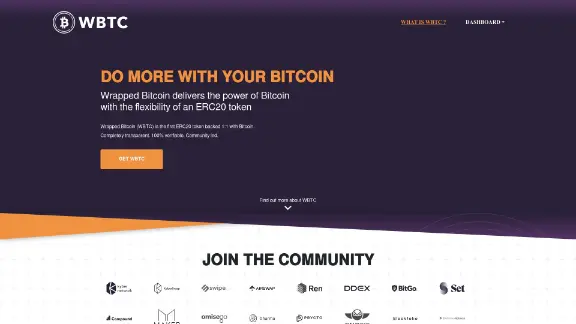Wrapped Bitcoin (WBTC)
Wrapped Bitcoin (WBTC) is an ERC-20 token on the Ethereum blockchain, backed 1:1 with Bitcoin. It enables Bitcoin holders to participate in Ethereum's decentralized finance (DeFi) ecosystem. By bridging Bitcoin and Ethereum, WBTC offers a store of value, investment opportunities, and liquidity. The integration allows users to leverage both the Bitcoin and Ethereum networks.
History
The Wrapped Tokens project, including WBTC, was initiated by BitGo, Kyber Network, and Ren. Launched on October 26, 2018, the project aimed to create an ERC-20 token that facilitates new applications for Bitcoin on Ethereum. This standardization allows Ethereum developers and decentralized exchanges to access Bitcoin's liquidity. BitGo, co-founded by Mike Belshe in 2013, serves as the initial custodian for WBTC, managing the tokens and keys necessary for minting.

| Ticker | WBTC |
| Category | Crypto-Backed Tokens |
| Website | https://www.wbtc.network/ |
| @WrappedBTC | |
| Contract Addresses | |
|---|---|
| ethereum | 0x22...99 Copied! Copied! |
Kyber Network, founded by Loi Luu, Victor Tran, and Yaron Velner in 2017, is a Singapore-based liquidity protocol that helps integrate cryptocurrency tokens and DeFi applications. It plays a crucial role in minting and burning WBTC tokens. Ren, established by Taiyang Zhang and Loong Wang in 2017, focuses on cross-blockchain integration for cryptocurrency assets and DeFi applications.
In January 2019, WBTC's whitepaper was released, and the token launched with eight merchants, including AirSwap, Dharma, and Kyber Network, facilitating Bitcoin-to-WBTC conversions. Many organizations joined the community effort, such as MakerDAO, Compound, and Radar Relay, supporting WBTC's adoption.
Early market cap growth
In early August 2020, WBTC experienced significant growth, with its market capitalization surpassing $230 million. This was driven by increased interest in the DeFi sector.
Record-breaking mint
On October 14, 2020, CoinList set a new record for the largest single-day mint of WBTC, producing 4,997 WBTC.
Technology
Minting
Minting involves generating new wrapped tokens. Merchants initiate this process by authorizing custodians to create new tokens on Ethereum. The merchant sends Bitcoin to the custodian, who waits for six block confirmations on the Bitcoin network. Upon completion, the custodian mints an equivalent amount of WBTC on Ethereum.
Burning
Burning involves exchanging WBTC for Bitcoin. Verified merchants create "burn" transactions using the WBTC smart contract. After 25 block confirmations on Ethereum, the specified WBTC amount is deducted from the merchant's balance, and the custodian sends Bitcoin to the merchant's address.
WBTC ecosystem
- Custodian: BitGo is responsible for the custody of Bitcoin for WBTC.
- Merchant: Merchants like Kyber and Ren play a vital role in minting and burning WBTC tokens.
- Users: Holders of WBTC can use it for transactions within the Ethereum ecosystem.
- WBTC DAO member: The WBTC DAO governs contract changes and the addition or removal of custodians and merchants.
Governance
The wrapped token contract is governed by a multi-signature contract, requiring signatures from DAO members to make changes. The "M of N" signature model is used, where M is the required number of signatures, and N is the total number of members. This system ensures both security and flexibility.
Utility
WBTC enhances liquidity in the Ethereum ecosystem, particularly in decentralized exchanges (DEXs) and financial applications. It standardizes Bitcoin to the ERC-20 format, enabling its use in Ethereum smart contracts. This facilitates Bitcoin's integration into DeFi applications and smart contract development.
WBTC DAO migration
On November 20, 2022, Victor Tran of Kyber Network initiated a migration of the WBTC DAO to a new multi-signature contract. The updated contract now features 13 signers instead of the previous 18. Several original members were replaced by new entities like Balancer and Chainlink. The migration was necessary to maintain the effective governance of WBTC contracts. After this transition, the DAO requires 8 out of 13 signatures for consensus, enhancing the decision-making process. On December 13, 2022, WBTC announced the successful collection of 11 signatures to commence the new DAO transition.
